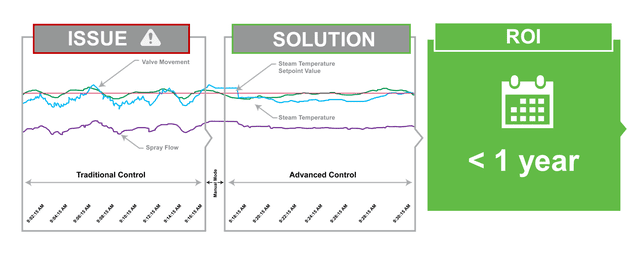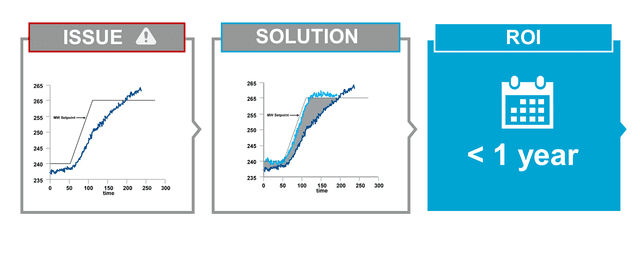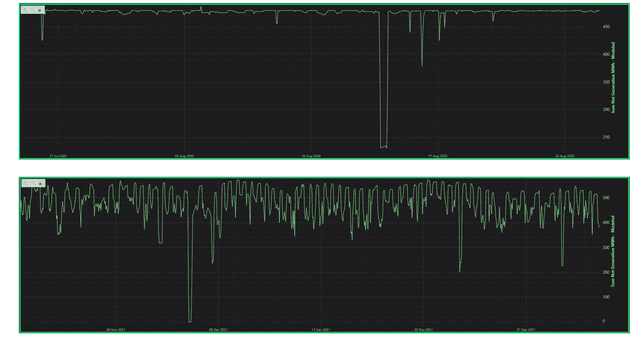Optimizing Power Plant Load Flexibility
The operating profiles of traditional generators has changed to manage the variability of renewable resources. Several critical processes were not engineered to manage these highly variable operating profiles and the associated transient conditions in an ideal manner, which has a negative impact on efficiency and reliability. Operators should consider applying field-proven advanced model-predictive control solutions to these process areas.
Utilities today are seeking to diversify their energy portfolios by increasing production from wind, solar, and other renewable sources. However, the intermittent nature of renewable generation can be challenging for traditional generating assets, as they must operate differently than intended at the time they went into service.
Take combined cycle units, for example. They are typically designed around steady-state conditions, meaning that operating performance targets are met when all the major components of the process are aligned. Initial design efforts typically focus on a unit’s full-load output condition; unit dynamic control is a secondary priority.
This is problematic. With an increase of renewables being added to the generating mix, these units are now spending more of their operating life in a transient or dynamic condition, often operating at lower minimum loads and higher ramp rates. In this new reality, there is a need to improve operational flexibility so that plants can more efficiently move through load changes while maximizing dynamic performance of plant processes and equipment.
Traditional control has relied on the ubiquitous PID (proportional-integral-derivative) controller algorithm, sometimes combined with a feed-forward mechanism. This type of control, when tuned and calibrated, provided a reasonable response to changing power demand, usually requested as long ramps between minimum and maximum limits.
However, the evolving operation profiles are often unpredictable and require these plants to ramp faster and “turn on a dime.” Due to the high-order nature and inherent transport delays of some of the key processes, such as steam temperature control and duct burner load generation, a PID controller is often unable to provide the robust control required. This is due to the nature of the mathematics associated with the algorithm and its subsequent ability to only generate a very approximate “model” of the process. Even with feed-forward mechanisms, PIDs lack the predictive, multivariable, and optimal control nature of modern model-predictive control algorithms and are often de-tuned to ensure system stability at the cost of dynamic response.
PID-Based Control Limitations
The key process areas where PID-based control limitations have been identified follow.
Drum Level. HRSG (heat recovery steam generator) drum level control has always been a challenge due to short-term dynamics like level shrink and swell related to quick load (steam flow) changes that cause sudden pressure transients. If the PID controller is tuned using conventional level control methodologies, shrink and swell can cause severe controller upsets because these dynamics are counterintuitive to the level controller, forcing the controller to be de-tuned. Three element control is often cited as the solution, where the mass balance between inflow and outflow is the primary control element and the level control PID acts only as a trim and is de-tuned to ensure stability. However, for three element control to be used, there needs to be consistently measurable steam and feedwater flows. This, unfortunately, is not always the case, especially on the intermediate pressure drum (smaller volume) of the HRSG as it often displays large disturbances of steam flow, in some cases even zero, during startups and load direction changes.
Steam Temperature Control. Operators sometimes run at lower-than-design steam temperature setpoints or lower ramp rates to avoid exceeding high steam temperature limits that could stress or damage the metallurgy in the piping, steam turbine, and other components. Operating heat rate is negatively impacted because the process is not running consistently at design temperatures and maximum efficiency. Steam temperature process time constants, often on the order of minutes, challenge conventional controls as they seek to chase the temperature impact of energy as it ebbs and flows to and from the process as load demand changes.
NOx Control. Traditional process control implementations for NOx rely on open loop design basis calculations following HRSG inlet NOx with a PID controller to provide trim control on the stack NOx. The inherent NOx measurement delay, potentially higher order reaction dynamics, and process noise all challenge traditional tuning and PID control.
Load Control. Long process delays change the combustion turbine exhaust energy, duct burner output, and the associated steam production, which increases steam turbine megawatt output. This can force either additional demand changes to the combustion turbine or de-tuning of the overall load management scheme to maintain the desired stability.
Duct Burners. Often, duct burner management is not closely coupled in automatic with the overall AGC (automatic generation control) scheme. This is because in addition to the high order nature of the load response, a multivariable control problem is presented in the form of managing HRSG steam/tube temperatures alongside the associated steam production, which is driven by duct burner modulation response to load demand.
Finding Flexibility with Model-Predictive Control
With plants operating differently, it makes operational and economic sense to consider a solution that overcomes the inherent limitations of conventional PID-based control. Model-predictive control software, in which a model of the transient response of the process is part of the control strategy itself, checks all the boxes. Embedding intelligence within the control strategy makes it possible to predict—and proactively control for—changing operational dynamics. This, in turn, translates into quicker response to combustion turbine output changes, and consequently, improved performance. This is evident by comparing the challenges of using conventional PID controls (above) with intelligent model-based predictive control as described below.
Advanced Drum Level Control. Model-predictive control anticipates changes in the rate of steam production based on energy changes from the combustion turbine or duct burners. It allows the control solution to steer predictively through transient shrink or swell dynamics while maintaining a high degree of robustness, even in single element and startup modes. Implementing advanced drum level strategy supports higher overall unit ramp rates with improved stability since the control solution is no longer constrained to chasing transient level impacts.
Steam Temperature Optimization. Advanced steam temperature control anticipates changes in steam production from the combustion turbine or duct burner exhaust energy, and proactively responds to changing process conditions for more stable superheater and reheater temperature control. This helps optimize efficiency by keeping steam temperature closer to its maximum efficiency point during transient and cycling operations while minimizing risk of high temperature excursions. Steam temperature optimization has a significant impact on operations and resiliency (Figure 1), typically offering a return on investment in less than one year.

SCR Optimization. There is often significant dead time when measuring NOx, which poses a major challenge for traditional PID control. However, predictive models can adjust for this by determining the quantity and timing of ammonia injection. This approach better maintains the desired NOx removal and helps to ensure emissions compliance throughout a more dynamic load profile. When optimization software is layered on the predictive control, the resulting solution steers to hourly or daily constraints, minimizing overall reagent usage.
Response Optimization. Predictive load control recognizes how and when steam turbine megawatts will be produced based on changes to combustion turbine exhaust energy and duct burner output. This makes it possible to achieve the desired overall unit output to setpoint more quickly while minimizing the control actions necessary on the combustion turbines or duct burner output. This reduces wear on plant equipment, better supports grid operations, and can provide additional revenue in markets where applicable. Implementing response optimization software also enables units to better engage and disengage with a market based on economic conditions, often allowing utilities to realize a return on investment in less than a year (Figure 2).

Duct Burner AGC. Predictive control strategies enhance duct burner operational flexibility. Its multivariable control ability intelligently couples both the combustion turbine and duct burner load management into a single optimal load controller. Duct burner AGC software provides both plant operations and power marketing the flexibility to make economic dispatch decisions with a single AGC front end.
Ramping Up Results
One of the derived benefits being realized from plant operators engaging in these solutions is the overall support they provide toward achieving a more autonomous level of plant operations. Applying a better technical solution in these critical areas allows the process to remain under automatic control over a wider operational range with improved stability, reducing the level of necessary operator interactions. This frees up limited plant operations staff to focus less on the moment-to-moment conditions and more on higher-level objectives, thereby leading to improved overall plant reliability.
It’s important to remember that the benefits that can be derived from model-predictive control are not simply theoretical, but tried and true. Hourly operating profile data from a utility located in the Midcontinent Independent System Operator (MISO) footprint provides a real-life example of the operating profile changes experienced by some sites that can be positively impacted by adopting advanced control solutions, such as model-predictive control.
The top illustration in Figure 3 shows the original typical hourly operational profile of a combined cycle unit in August 2020 when it was mainly baseloaded, focused on maximizing production output and efficiency. The lower illustration in Figure 3 shows the profile in December 2021 when the unit was operating in its “new normal,” which includes an increased need to respond to changes in system demand due to the penetration of new variable types of generation and evolving market conditions. Through adoption of the solutions as described in this article, this site has adapted to the operating profile changes while improving the overall control performance in critical process areas.

Today’s traditional power plants are actively asked to increase and decrease load in real time in response to renewable energy variability on the grid. In this energy landscape, it’s imperative to find ways to increase the flexibility of these units. However, achieving better load flexibility requires accurate management of combustion turbine energy and emissions by the HRSG—something that can be difficult to optimize with traditional PID control schemes. Model-predictive control is a proven solution that:
- ■ Responds predictively to dynamic conditions caused by constant load changes.
- ■ Balances—in real time—multi-dimensional objectives and tradeoffs that are inherent to plant operation.
- ■ Monitors model drift to understand if the underlying process is evolving, and if so, when it needs to be addressed.
Ultimately, this embedded understanding of response characteristics and leveraging them can help power plant operators improve operational flexibility; optimize dispatch; increase reliability and availability; and optimize environmental performance of combined cycle and other traditional power generating units.
—Jim Nyenhuis is manager of Performance Consulting for the Power Industry and Ranjit Rao is manager of Advanced Applications and Optimization for the Power Industry, both with Emerson.